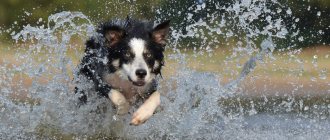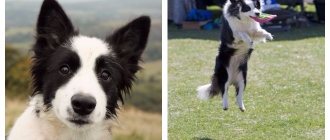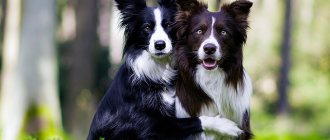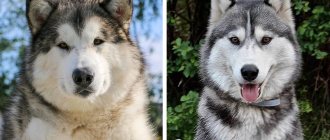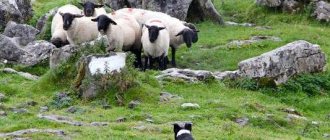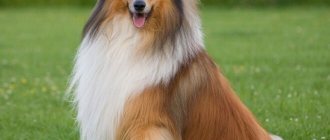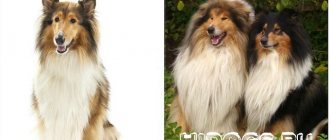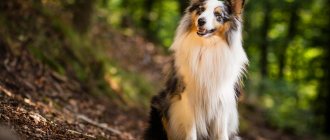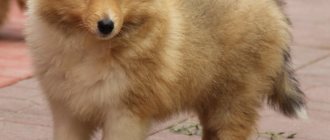History of the Border Collie Breed
Border Collie Puppy
The closest ancestors of today's Border Collies were the sheepdogs of English peasants who lived on the border with Scotland. Hence the name of the breed – border collie (from the English “boarder” - “border”). These picky and playful dogs herded flocks of sheep, guarded estates and did not annoy their phlegmatic owners with loud barking. At the same time, “farm collies” were not valued by the British nobility and for a long time remained typical rural dogs.
A chance meeting of its representatives with the Queen of Great Britain, Victoria, helped bring the breed out of the shadows. In 1860, English Shepherds took part in one of the first dog shows, after which they were introduced to the royal court. “Grandmother Europe” liked smart and loyal animals, so soon several representatives of this glorious breed settled in Buckingham Palace. Throughout Victoria's reign, many border collies lived in her chambers, but the queen's main favorite remained a dog named Sharp, who was honored after his death with an impressive memorial in Windsor.
It was possible to officially register the Border Collie breed only in 1915, although the standard of appearance for its representatives remained unformed for another 60 years.
The most famous ancestor of modern border dogs is considered to be the Old Hemp Shepherd, born in 1893 in Northumberland County. The handsome, strong, tri-colored male was distinguished by his outstanding intelligence and exemplary behavior, for which he was selected as a sire for subsequent mating. It was the grandchildren and great-grandsons of old Hamp who achieved their first successes at exhibitions, becoming prize-winners of international and European championships. Another famous representative of the breed is the dog Winston, recognized as the official symbol of the boarder club. According to breeders, all modern individuals carry Winston genes.
Appearance of a border collie
Border Collies Love to Cuddle
Border Collies are far short of the title of glamorous hunk. A modest spotted or marbled color, average size, light shaggy coat to this day identify them as typical “villagers”, whose main vocation is to run across the heather wastelands, drive away uninvited guests from their homes and herd sheep. But the lack of external gloss is more than compensated by the amazing charm and intellectual inclinations of the animal. According to the breeders of these charming, modest dogs, the remarkable intelligence of the Border Collie can be seen in their eyes.
Head
Wide skull with a smoothed occipital part. The cheekbones are normal, without roundness, not flat. The cheeks are medium, without excessive fleshiness. The muzzle is of medium width, tapering slightly towards the nose. The transition from the nose to the frontal part is clearly expressed. The length of the muzzle is approximately equal to the length of the skull.
Jaws
The Border Collie's jaws are strong, strong, with a regular scissor bite (the upper canines cover the lower ones). The teeth are white and evenly spaced.
Eyes
Oval, medium size. The distance between the eyes is wide. The color of the iris is brown, but blue eyes are allowed for border collies with a merle coat color. A wise, searching look.
Ears
Triangular, medium size, moderate thickness. Widely spaced. Both standing and semi-standing stances are acceptable.
Border collie muzzle
Nose and lips
The Border Collie's lips are dry. The nose is black, slate (if the coat is blue) or brown if the individual has a chocolate coat color. The nose is of medium size, the nostrils are large.
Neck
Hidden handsome man
Elongated, with excellently developed muscles, strong. There is a slight bend.
Frame
Wide and deep chest. The upper line of the back is characterized by a slight slope towards the tail. The lower back is muscular, the groin line is not tucked. The ribs are springy and round in shape. The croup is medium wide, elongated and slightly sloping.
Legs
The Border Collie's forelimbs are set parallel. The elbows are pressed to the sternum, the shoulder blades are tilted back, but do not close together. The hind legs are well muscled, wide, and have a sloping line at the base of the tail. The hock joints are low and slightly sloping back. The paws are in the shape of a regular oval with massive black pads and toes that gather into a “lump.” The claws of the paws are short and thick.
Tail
The tail of the Border Collie is saber-shaped, of medium length, reaching the hock joints. Fluffy, bends with a slight curl closer to the tip. In an emotionally excited individual, it often rises to the level of the upper line of the back.
Border collie black with white spots
Marbled Border Collie
Wool
Border collies can be either smooth or moderately long-haired. Representatives of both varieties have a springy soft undercoat that performs warming and water-repellent functions. Unlike smooth-haired individuals, long-haired individuals can boast of having a lush neck “collar” and fluffy “panties”. Some dogs may have so-called “feathers” or “feathers” on the back of their front legs. In this case, the muzzle, ears and front part of the forelimbs should have smooth and short hair.
Brown and caramel colored border collie (tan)
White Border Collie
Color
Border Collie Color Chart
To date, there are no restrictions on the types of colors of border collies. However, black with white spots or tan, chocolate with light tan and white markings, and merle (blue or merle) are still considered priorities. White markings are usually located on the forehead, chest, paws and tail and may have a speckled coloration.
Important: animals whose dominant color is white are not allowed to participate in exhibitions.
Dimensions
The average weight of an adult does not exceed 15-20 kg. Bitches are slightly smaller than males; the standard height for a female dog is 47-52 cm, for a dog - 50-53 cm.
Appearance defects and disqualifying faults of the Border Collie
The most loyal selection criteria apply to shaggy natives of English farms. Only an aggressive or cowardly dog with an inadequate reaction to speech addressed to it and that does not meet the FCI standard can be banned from participating in exhibition and competition events. All other shortcomings are mercifully forgiven to borders.
Generally recognized breed standards
FCI Standard No. 296 dated 10/19/1988. Translation by RKF.
Breed classification:
- country of origin: UK;
- Application: companion dog;
- general impression: an intelligent, alert dog of medium size, harmonious build with an elongated head and pointed muzzle;
- Behavior/temperament: cheerful, friendly, never nervous or aggressive;
- FCI classification: group 1: herding and cattle dogs;
- section 3: shepherd dogs (herding dogs);
- no operational tests.
- FCI,
- males: 56–61 cm;
- males: 20.5 – 29.5 kg;
Table: external features of the breed
| Options | Description |
| Head | When viewed from the front or side, it resembles a blunt, clean wedge with smooth outlines. The point in the middle between the inner corners of the eyes is the center of balance of the head along the length |
| Scull | Flat. The lateral lines gradually taper from the ears to the tip of the nose. The depth of the skull from the eyebrows to the lower jaw is not deep |
| Stop | Lightweight but noticeable. The center of a correctly positioned stop transition is the midpoint between the inner corners of the eyes |
| Nose | The lobe is large, always black |
| Muzzle | Long, but not pointed, the ending is rounded and blunt. The length of the muzzle is equal to the length of the skull |
| Jaws/teeth | Correct scissor bite. The lower jaw is strong, clearly outlined by black lips. Jaws strong, strong |
| Eyes | Medium size, almond-shaped, dark brown (in the blue merle color there are blue eyes or with blue splashes). Lively, intelligent and vigilant look |
| Ears | Small, widely spaced, semi-erect type |
| Neck | Muscular, strong, appropriate length, well arched |
| Frame | Slightly longer than the height at the withers, the back is horizontal, strong, with a soft rise in the lower back, well sprung ribs, deep chest, rather wide at the shoulders |
| Tail | Long, the end of the last vertebra reaches the hock joint. When at rest it is lowered, the end is slightly bent upward |
| Forelegs | The shoulders are sloping, with well-defined angles. The forelegs are strong and muscular, with elbows turned neither out nor in, and moderately bony. The forearms are very muscular, the pasterns are flexible, but not weak. |
| Hind limbs | Hind legs with muscular thighs, dry and sinewy below, with good knee bend. Metatarsus low, strong |
| Paws | Oval soles with good pads. The fingers are curved and closed together. The hind legs are slightly less curved |
| Wool | Short, close-fitting, the guard hair is hard, with a very dense undercoat. Cannot be trimmed or trimmed |
| Color | Three colors are recognized:
|
| Movements | Powerful and energetic. When viewed from the side, the movements are smooth. A moderately long stride is desirable. It should be done easily, without effort |
| Violations of the standard for which points are deducted | Any deviation from the above points should be considered as a defect, the assessment of which should be in strict accordance with the degree of this deviation |
| Disqualifying Faults |
Note: Males must have two apparently normal testes fully descended into the scrotum |
Gallery: Shorthaired Collie colors
Blue Merle Color: Predominantly clear, silvery blue, flecked with black spots like merle
Tri-color: predominantly black with red markings on the legs and head
Sable color ranges from light gold to rich mahogany
Photo of an adult border collie
Border Collie Personality
Master, I love you so much ❤
Border collies are observant, good-natured hard workers with an extremely peaceful character. English Shepherds will always prefer completing some important assignment or intense training in the fresh air to lying aimlessly on the rug. For these dogs, work is not a routine, but the meaning of life, so you should not try to transform an energetic border dog into a “couch city dweller.”
Border collies are not considered aggressive dogs, but the animals still experience a certain distrust of strangers. But these modest intellectuals love children quite sincerely. Of course, you can “graze” them all day long, tirelessly driving individuals who have strayed from the “herd” into a safe zone and not letting them out of it until permission is received from the all-powerful and respected owner. By the way, about the relationship with the owner: it is difficult to find a creature capable of loving you more than a border collie. These executive workaholics are ready to completely and completely dissolve in their owner, without demanding anything in return.
Border collie herding sheep
Got it!
Character and intelligence
The Shorthaired Collie is a friendly dog, not aggressive or nervous. She is moderately proud, moderately calm, very attached to her owners, and treats strangers with suspicion or indifference. Because of their docile temperament, collies are increasingly being adopted by residents of city apartments, because they are so friendly, obedient, and positive.
One of the distinguishing qualities of these dogs is the ability to adapt to any lifestyle, which can be active or calm without compromising the collie's psyche. These dogs are very delicate and unobtrusive, hardy and self-confident.
Smooth Collies are more energetic than their long-haired relatives. They are cheerful, inquisitive and active dogs who always try to be in the center of events and love affection and attention. They get along very well with any other pets, including dogs. Aggression is not typical for them, but in critical situations they can show themselves and come to the owner’s defense. Their work requires them to actively use their voice, which is why many collies are very talkative.
The intelligence of collies is much above average, which is why they rarely have problems, are easy to train, are obedient and perform remarkably well in various sports.
Education and training
Borders are dogs that require not only regular physical activity, but also constant training. They pick up lessons on the fly, and in addition, this is one of the few breeds that does not need to be endlessly stimulated with treats in order to master the simplest skill. And yet, discipline and perseverance in puppies are poorly developed: if an animal is tired of following monotonous commands, it will simply change the type of activity to another, from its point of view, more interesting.
Fast, smart and happy
The owners of boarders themselves call their pets the best fitness trainers for the simple reason that with them there is no time for passive rest. Standard walks at a sluggish, relaxed pace will not work with these comrades. The Border Collie requires a full run with games and complex tasks for intelligence and dexterity. Frisbee, flyball, bike joring, agility, diving - these are the standard activities that representatives of this breed very quickly get hooked on. Shepherds also respect hide-and-seek and chase, but sometimes they can lose control of themselves and, during the game, lightly bite the legs of the person running away.
Border Collies are good at listening to human speech and understand the meaning of many words. Some owners use this feature in games. For example, the names of toys are learned with the animal, after which the owner says the word denoting the object, and the dog must bring exactly the toy that the person asked for. Pets are no less delighted by hunting for a hose connected to a water pump and catching soap bubbles. Simply put, border collies love everything that involves the manifestation of at least some physical activity.
Border Collie training
Forced idleness is fraught with mental disorder for the animal, and inevitable financial losses for the owner. A bored dog can turn even a perfect apartment into the set for a post-apocalyptic blockbuster. Border puppies are a bit headstrong, which is not a good reason to postpone training until a later period. The sooner you teach your pet the rules of behavior in the house/apartment, the less material damage you will suffer.
Usually puppies are ready to learn simple commands at the age of 3-4 months. The average duration of training for a baby is 10-15 minutes, after which the animal begins to experience boredom and fatigue. Once the dog reaches 6 months of age, the training becomes more complicated, without forgetting to repeat and consolidate the material covered. You can train and raise your pet yourself, by trial and error, or you can entrust this matter to a professional. The advantages of the second option are obvious: the animal quickly masters a basic set of skills, and the owner saves his own time and nerves.
Something is wrong here...
Two friends
Character traits
Collies require companionship and close contact from their breeder and all family members. It is very important for animals to occupy a certain position in the social hierarchy of their “pack”. If you deprive your pet of attention and affection, the dog may experience various behavioral disorders.
In general, the short-haired collie is distinguished by its excellent qualities as a companion; it is not prone to intrusive behavior, but will run ahead of everyone else when going for a walk. For a child, a dog will become an interesting and loyal friend.
Many breeders characterize the Scottish Sheepdog as the best nanny, especially for female dogs. When a new family member or pet appears, collies react calmly.
The dog prefers to demonstrate its emotions (both positive and negative) by barking, but mindless expressions of the pet’s voice should not be encouraged, otherwise it can turn into a real problem. The dog is not aggressive towards strangers, strangers are rather uninteresting to her, however, in some animals, in particular males, ancient instincts may awaken, then they will jealously guard their family and territory.
Collies have a hard time being alone for long periods of time, so by being away all day, the breeder will need to compensate for the lack of communication upon returning home. In general, the character of the short-haired collie is characterized on the positive side; the dogs are balanced and do not suffer from excessive suspicion and aggression.
Care and maintenance
The ideal habitat for borders is a country house or farm, where nothing will limit the activity of the animal. Keeping representatives of this breed in apartments also takes place, but only under the condition of good walking. If this is not possible, you should choose a less active pet.
Hygiene
I don't like baths...
When purchasing a Border Collie puppy, it makes sense to invest in a powerful vacuum cleaner, since Border Shepherds shed, although seasonally, extremely profusely. During the shedding period, you need to comb your dog at least once every two days, otherwise you will have to deal with tangles. In the interval between molts, it is enough to do this procedure once a week. Before combing, the wool is slightly moistened with a conditioner diluted in water, which should significantly facilitate the process. The use of slicker brushes and furminators is not recommended, as their use negatively affects the structure of the coat.
To speed up the molting process, experienced breeders recommend using a simple recipe:
- dilute a small amount of shampoo in water and bathe the dog;
- repeat the procedure again;
- fill the bath with clean water and dilute conditioner balm in it;
- moisten the animal’s fur with the resulting solution (rinse off is not necessary);
- blot the wet coat with a towel and comb thoroughly, thus removing the bulk of the undercoat and guard hair.
Another thing!
Border collies love to swim in open water, but are uncomfortable in the bathtub. You should wash your dog with a special shampoo no more than once every 1-2 months.
Border dogs have their nails trimmed once a month. If the pet leads an active outdoor life, this procedure can be neglected, because during jogging and training the claw plate is simply erased.
To prevent the appearance of tartar and remove plaque, you can give your dog tomato juice or treat it with “cleansing” bones from time to time. Close attention should be paid to the ears, which actively “collect” all kinds of pollution. The ear funnel should be cleaned with a cotton pad soaked in lotion, which can be purchased at any veterinary pharmacy.
Feeding
The Border Collie's daily menu must include meat (preferably not pork) and offal. The meat is served raw. If it is a frozen product, it should be doused with boiling water. It is allowed to include frozen sea fish in the animal’s diet, from which the bones have previously been removed. In addition, it is useful to mix fish oil, kelp and vegetable oil into the food, which serve as a source of essential amino acids and microelements.
Broccoli, zucchini, green beans, pumpkin, spinach and green apples are essential foods in a Border Collie's diet. They are usually served mashed or chopped in a blender. Sour milk and eggs are given once a week. The most useful cereals are buckwheat and rice. For training, you should choose treats based on dried liver, as well as any other delicacies with a reduced fat content, approved by veterinarians.
Of the dry foods, the most useful are options with salmon, turkey and lamb. Since the activity of most borderers is off the charts, the optimal diet for them would be a “dry” diet with a high content of protein (about 30%) and fat (up to 20%). In addition, the right food should contain chondroitin and glucosamine, as well as sources of Omega-3 and Omega-6. Varieties based on meat by-products, as well as foods containing soy, corn and wheat, do not have the best effect on the dog’s digestive system.
Oooh.. mushroom
It's all for me?
Border Collie Health and Diseases
The average lifespan of dogs is 12-13 years. An elderly animal can be identified by its attraction to a calmer lifestyle, while the appearance of border dogs remains unchanged even with age. As for hereditary diseases, there are few of them. The most common conditions that Border Collies suffer from are hip dysplasia, osteochondritis dissecans, retinal atrophy, and epilepsy. Some individuals may have a congenital eye abnormality, often leading to blindness. An animal affected by this disease can be identified as early as 10 weeks of age.
Border collies are sensitive to barbiturate anesthetics, which is due to the low content of adipose tissue in the dog's body. Extremely rare, but still occurring is a disease such as hypothyroidism, accompanied by disturbances in the functioning of the thyroid gland and hair loss. Pets of lazy owners usually suffer from obesity, which is a direct consequence of a passive lifestyle, as well as overfeeding the dog.
Character
What makes a Collie a great family dog is its character. There are a number of advantages of the animal's character.
The first is intelligence. All shepherds are intelligent. This is also true for short-haired Collies. Some of them compete in this regard with their Border relatives. Training a puppy does not cause any problems, unless, of course, you show excessive aggression. The breed is distinguished by pride - if it is humiliated, this will have a bad effect on its psychological health (neuroses among dogs are not such a rare occurrence). With proper upbringing, the dog will never spoil the home interior, and will also learn to understand commands.
The second virtue is playfulness. Quiet dogs like shorthairs or border collies are perceived by many as boring. This is not the case with Collie at all. Yes, they can be quiet for quite a long time, but if a child invites them to play, they will happily keep him company. Moreover, the dog’s energy will most likely lead to the fact that you won’t have to put your son or daughter to bed in the evening: he would crawl to bed himself.
And finally, the third advantage is their affection. While still a puppy, short-haired Collies perceive their owners as relatives, beloved members of the pack and patrons. With age, these feelings only intensify. Collies are very loyal to their owners. This should be remembered, since it is much easier to hurt feelings in such conditions. Collies are not vindictive, but a mental wound for these noble dogs (especially puppies) is no less dangerous than a physical one.
How to choose a puppy
We choose an active, sociable, moderately well-fed animal and refuse lethargic, apathetic puppies with dirty ears and a dry nose. You should first get to know the parents of the future pet, and of course, clarify information about the vaccinations given to the dog. If pedigree and standard appearance are important, it is better to contact well-known nurseries.
In order to save money, you can go through virtual bulletin boards like Avito and buy a border collie puppy “from hand”. Sometimes unscrupulous sellers, under the guise of purebred puppies, sell mongrels of a similar color or mixed breed, so it is better to come to a meeting with the owner of the animal with a specialist who can distinguish a purebred from a pseudo-border.
Choosing a puppy
A prerequisite for purchasing a baby is the presence of documents and vaccinations. Choose a breeder in advance, look at the parents, find out about diseases. When choosing, you need to pay attention to the pigmentation of the nose - if it is not completely colored, then there is a possibility that the pigmentation may be disturbed. But usually by the year everything falls into place.
An important indicator is the absence of more white color. Marble babies have more breeding defects, but this does not mean that everyone has them.
The puppy is active, well-fed, inquisitive. Babies leave for a new home at the age of 1.5 - 2 months. You need to prepare a bowl, toys and food.
Price
Depends on the pedigree of the parents, titles. Show class and individuals that show great promise in the future cost twice as much as pet class. Cost from 30 to 70 thousand rubles.
Photos of border collie puppies
How much does a border collie cost?
An animal from a decent nursery will cost 50,000 - 60,000 rubles, and chocolate-colored borders are more expensive. In advertisements from single sellers, the average price tag for a border collie puppy with the RKF metric is approximately the same. The cost of babies from titled parents can reach 70,000 rubles. Purebred dogs with minor defects cost 25,000 - 35,000 rubles. Metis without documents, who are barred from entering exhibitions and competitions, are often given away free of charge or for a nominal fee.


